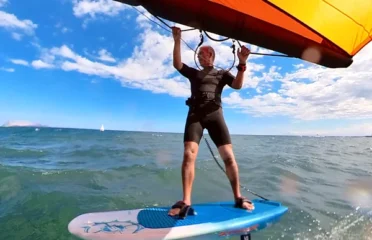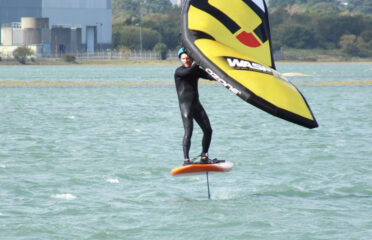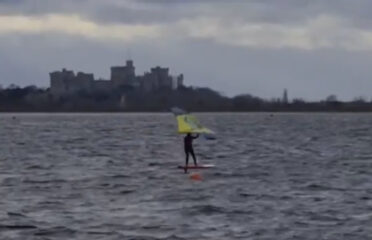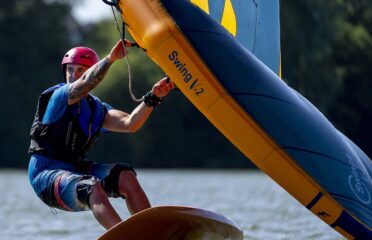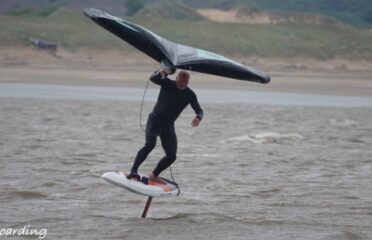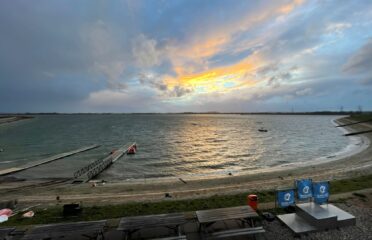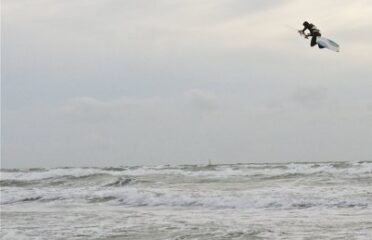Your First Sessions
Here’s a list of equipment you’ll need to get started:
Wing, Foil
Board, Board Leash
Wing Leash, Wing Pump
Helmet, Wetsuit, Bouyancy Aid
Rider Simplicity
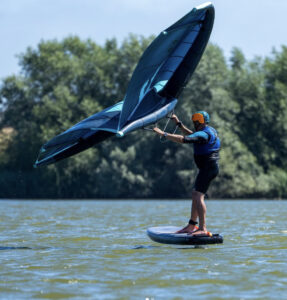
‘Rider Simplicity’ was a phrase coined by a major kitesurfing brand a couple of decades ago. But nothing is simple about carrying and running out 4 x 20m lines and finding a clear space to launch and land.
Wing foiling has edged us closer to this promised simplicity – if you ignore all the parts in the foil. Well it’s thrown out the bar and lines, so its some progress right?
Maybe one day we’ll ditch the wings and just pump the foil, but until then there’s quite a few things you’ll need in order to start wing foiling.
Top Tip
My advice for learning, even if you have great balance from other watersports, is to GO BIG on your first board.
And go for FLAT WATER on your first few (15 ish !) sessions. Give yourself the best chance of getting up on the foil by finding shelter from the waves.
Wing
Buy your wing first, you can pump it up and start to learn how to handle it, power up and de-power, steer it and flip it over.
Wings are already very advanced for a new sport given all the R&D that’s come across from leading edge inflatable kites.
You’ll need more power than you think to get up on the foil in your first sessions. You’ll feel like you’ve been miss-sold the sport, you’ll want to make a claim, but just stick it out – it will all come together at some point.
Unless you’re under 70kg or live in a wind tunnel you’ll need a 5m2 wing. If you’re a larger rider and especially if riding inland it might be best to start with a 6-6.5m2 wing. The span of the more recent wings in these larger sizes > 5m2 isn’t very different to smaller wings, they’re just deeper. You can get away with one wing until you want to go out in over 25 knots or if you plan on pushing the limits of light wind riding. Wing sizes range from 3m – 8m2.
As a beginner one wing will do. It is easier to get on the foil with more power than less and therefore you’ll want to go out in stronger winds or start on a bigger wing.
You’ll need to make some choices on boom vs handles and leash attachment for wing. Waist vs wrist. Most riders use wrist leashes, some will choose a waist leash if planning on using both arms to paddle out through surf.
The best thing to do is demo a few different brands of wing.
Kite pumps work well for wings, usually the same fittings. Inflatable wing board pumps will come with connectors for the wings.
Board
Beginner wingers should start with something wide and floaty. A good rule of thumb is to have 30-40 liters of volume over your body weight. For example, if you weigh 90kg, go for a 130L board.
You’ll be able to move down to a smaller and more manoeuvrable board later on, the second hand market for these large boards is buoyant 🙂 Maybe buy a second hand board then flip it after you’re ready to drop 20 litres for your next board.
With bigger and wider boards your balance doesn’t need to be as good and you can concentrate on the wing.
Some boards have a small fin up the front, if you are winging on a gusty lake or reservoir I would recommend using this. It will help you ride back up wind even if not up on the foil very often on each tack.
You’ll need a board leash, go for a waist leash, it minimises tangles during gybes.
Foil
The foil consists of a mast (mast plate), fuselage, front wing and stabiliser (stab).…
…..and loads of small bolts and a tool. Make sure to keep these bolts in a pouch so you don’t lose them. Buy some spare bolts to avoid disappointment when they go missing.
Most brands will manufacture a beginner foil, stable with lift at low speed. These are slower at the top end than more advanced higher aspect foils, but it’ll feel fast to begin with.
You’ll need a mast around 80cm, its a good height for most locations.
Make sure to buy some Teflon gel like tif-gel for assembly of the components. The materials used in a foil are dissimilar, aluminium mast, stainless bolts etc, throw in some salt water and it’ll turn into a battery, corroding parts and potentially seizing up threads.
As you progress, you can upgrade to a front wing and stabiliser that allows for better acceleration, higher top speed and excellent turning capabilities.
Safety Kit
I would recommend wearing a helmet, the foil has so many sharp edges and hard bits to knock into. Some helmets, like the Simba Sentinel offer protection for some of your face/cheek bones as well as head.
At most reservoirs and lakes, buoyancy aids are mandatory. They’re a good idea and offer protection to your chest for impacts. There’s also impact vests, which are a lower profile but offer less bouyancy.
Wing Foil Lessons/Tuition
Wingfoilguide recommends that you take some lessons, especially if you’re new to watersports.
You’ll learn good techniques and safety practises under supervision….and you won’t need your own equipment!
Here’s some listings for locations that offer wing foiling Tuition:
Queen Mary Reservoir
- 4.0/ 5 1 Rating
- Inland
Friendly club with excellent facilities. Very popular with wing foilers and wind surfers. Large...


